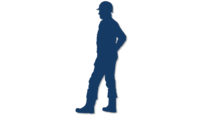The footwear you choose has health benefits

Construction jobs require intense labor, and construction workers are looking to increase their stamina by working smarter and not harder. This starts with having the right footwear. A well-made pair of boots is a tool to hold up to the rigors of the construction site, provide protection, and reduce foot and back pain. Features such as a supportive insole are crucial to overall comfort and personal stamina. In some situations, protective footwear can be the difference between a broken bone and a lost appendage. Those who have encountered even a tiny injury are more cautious and continue to depend on safety boots to get them through their workday.
Most safety footwear is tailored to a specific need, addressing specific functions. Let’s discuss some representative end users and the footwear they may need to accomplish the job at hand while also complying with safety standards:
Pipe fitters and steam fitters: Responsibilities include the installation of drains, water mains, sewers, oil lines and gas lines on site. Steam fitting is a specialized field of pipe fitting and involves moving high-pressure liquids, steam, or other gases safely from one place to the next.
Recommended footwear for this end user has an all-rubber outsole that is oil and slip resistant with an electrical hazard ASTM rating, medium to deep lug depth/tread for multiple terrains, Goodyear welted construction for durability, ASTM standard protective toe cap, ASTM rated metatarsal guard (internal or external), and waterproof leather for dry and wet conditions. Additional features include insulation and a puncture-resistant plate, as required per the work conditions.
Other jobs that apply to this type of footwear: Duct workers/tile installers
Sheet metal workers: Responsibilities include construction, maintenance and installation of numerous types of metal for signage, ventilation ducts and additional needs. This field requires material knowledge, patience and expertise to ensure safety on the job while dealing with sharp and awkward-handling materials.
Recommended footwear for this end user would include an all-rubber outsole that is slip resistant. An outsole that is polyurethane would also be acceptable due to the nature of the job; standing long hours is very stressful on the body, so an outsole that absorbs shock such as polyurethane could be desired. Low to medium tread depth that is slip resistant, self-cleaning and has a majority surface contact is preferable. Goodyear welt, opanka, direct attached and cement constructions are all acceptable since the end consumer would like the footwear to be long wearing, comfortable, lightweight, flexible and durable. Depending on the region, insulated or waterproof footwear may be important. Protective toes, metatarsal guards and puncture plates may not be required for this occupation, but could be desired.
Other jobs that apply to this type of footwear: Duct workers/tile installers
Painters and paperhangers: Painters and paperhangers focus on the finishing details of a construction project, whether it is painting, staining or papering. These workers are very detailed and aware of the design and aesthetic elements of their labor.
Recommended footwear for this job includes anything from sneakers to boots, with either an all-rubber or shock-absorbing Polyurethane outsole. Most of these workers choose a smooth outsole (so they do not track mud, dirt and debris). Also, a non-marking outsole for this type of work is normally required since they may be walking on or over carpet and finished floors. Protective toes and most features other than a non-marking outsole may not be required, unless this footwear is used as a cross-functional type.
Other jobs that apply to this type of footwear: Insulation workers/carpenters
Drywall installers: Drywall installers work with mixtures and materials that can be easily manipulated and finished. Workers in this area of construction can encounter broken bones from dropping heavy drywall on their feet or getting their fingers jammed during installation, and respiratory problems
due to inhaled dust and debris from the material worked with.
Recommended footwear would be a rubber, polyurethane, or EVA outsole that is non-marking and a low tread depth for increased slip resistance and surface contact. A protective toe cap ASTM standard, metatarsal guard (internal or external) ASTM rated would be highly recommended and beneficial in this trade.
Other jobs that apply to this type of footwear: Tapers/terrazzo workers/roofers (NOTE: This type of job may require a roofer’s boot. Smooth slip-resistant outsole with a 90-degrees breasted heel for ladders.)
Brick, stone, cement masons: Working with stone, brick, and cement is very labor-intensive. These materials have been used throughout history to build structures we still live in. Brick and stone masons build, repair and maintain walls, stone floors, fireplaces and chimneys. Cement masons place and organize the distribution of cement throughout various places in a project.
Recommended footwear for this end user would be an all-rubber outsole that is oil and slip resistant with an electrical hazard ASTM rating, medium to deep lug depth/tread for multiple terrains, Goodyear welted construction for durability, ASTM standard protective toe cap, ASTM rated metatarsal guard (internal or external), and waterproof leather for dry and wet conditions. Additional features include insulation and a puncture resistant plate, as required per the work conditions. Workers in this profession typically expect the life of their boot to be six months due to the abuse of the job.
Other jobs that apply to this type of footwear: Concrete finishers/segmental pavers
Many types of construction jobs require different combinations of protection. In identifying the majority of these types of jobs, I hope I have conected the link between the job atmosphere and the type of footwear that will be a necessity on the job site. In a job that requires intense labor, workers are looking to increase their stamina by working smarter and not harder, and this can begin with footwear. A well-made pair of boots is not only a tool that defends feet against the rigors of the construction site, but with a supportive insole, can also reduce foot and back pain. In some situations, protective footwear can be the difference of a broken bone or lost appendage. Those who have encountered even the slightest injury are more cautious and continue to depend on safety boots to get them through their workday.
Website references
#1.) http://www.resource4constructionsiteaccidents.com/topics/typesofconstructionworkers.html
#2.) http://wiki.answers.com/Q/What_sort_of_jobs_are_in_construction#ixzz1uUcr4thl
#3.) http://www.articlesbase.com/careers-articles/different-types-of-construction-jobs-2293271.html
Looking for a reprint of this article?
From high-res PDFs to custom plaques, order your copy today!




